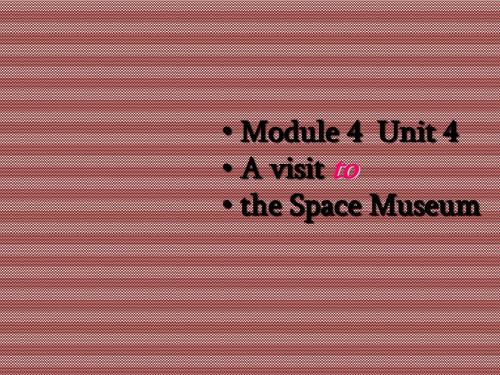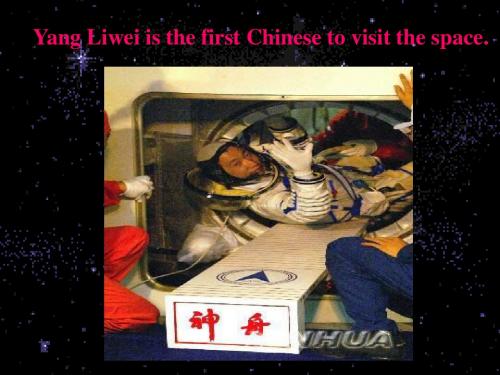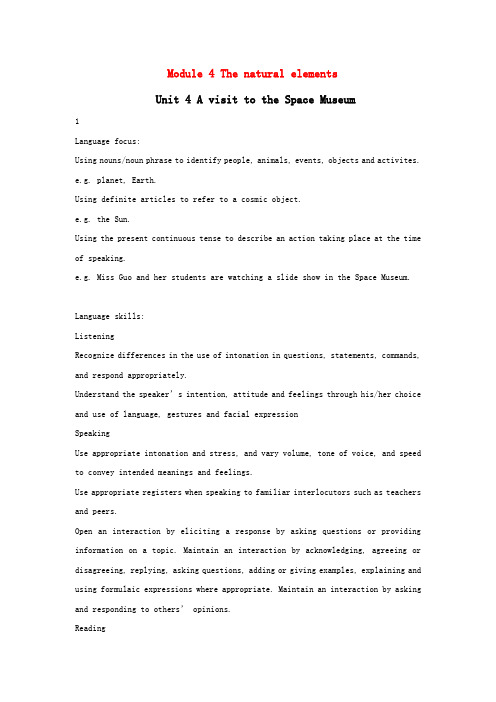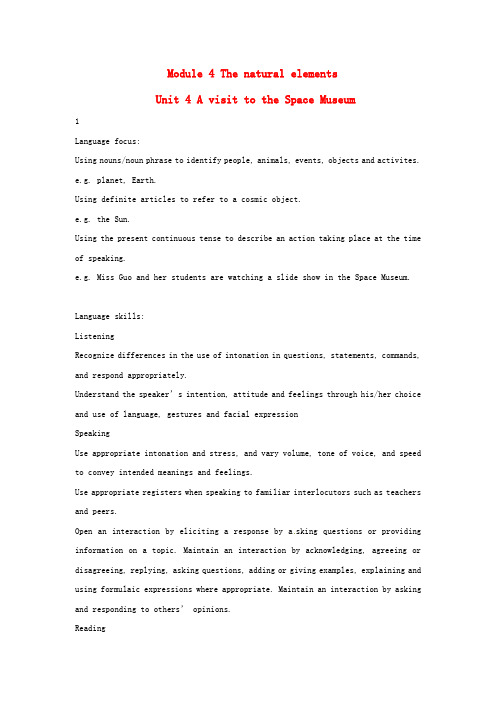A visit to the Space MuseumPPT
- 格式:ppt
- 大小:251.50 KB
- 文档页数:23



Module 4 The natural elementsUnit 4 A visit to the Space Museum1Language focus:Using nouns/noun phrase to identify people, animals, events, objects and activites.e.g. planet, Earth.Using definite articles to refer to a cosmic object.e.g. the Sun.Using the present continuous tense to describe an action taking place at the time of speaking.e.g. Miss Guo and her students are watching a slide show in the Space Museum.Language skills:ListeningRecognize differences in the use of intonation in questions, statements, commands, and respond appropriately.Understand the speaker’s intention, attitude and feelings through his/her choice and use of language, gestures and facial expressionSpeakingUse appropriate intonation and stress, and vary volume, tone of voice, and speed to convey intended meanings and feelings.Use appropriate registers when speaking to familiar interlocutors such as teachers and peers.Open an interaction by eliciting a response by asking questions or providing information on a topic. Maintain an interaction by acknowledging, agreeing or disagreeing, replying, asking questions, adding or giving examples, explaining and using formulaic expressions where appropriate. Maintain an interaction by asking and responding to others’ opinions.ReadingScan a text to locate specific information by using strategies such as looking at headings and repeated words.Materials:Student’s Book 7B page 82Workbook 7B page 45Pre-task preparationLanguage learning activity(This section aims at providing students with opportunities to practise the language/vocabulary needed or become familiar with the background for the task that follows.1. Ask students if they have been to the Space Museum. Ask them what they saw at the Space Museum. Invite students to tell the class about their experiences at the Space Museum; what they saw, what they did and where they went, etc.2. Ask students what they know about the solar system. Ask them questions like: How many planets are there in our solar system? What are their names?3. Introduce the names of the nine planets to students. Make sure students can pronounce and spell the names correctly.4. Students work in pairs to write the names of the planets in the correct order; starting from the planet closest to the Sun to the planet farthest from the Sun. Get students to discuss in pairs.5. When students have completed the task, have a few pairs give their answers to the class and the whole class checks the answers together.6. Students work in groups. Invite each group to choose a planet in the solar system they would like to know more about. Encourage students to go to library to find out some information on their chosen planet. Ask students to share their findings in class.ConsolidationWorkbook page 452Language focus:Using adjective to make comparisons.e.g. Jupiter is the largest planet in our solar system.Using prepositions/prepositional phrases to indicate position/place/direction e.g. Which is the closest planet to the Sun?Language skills:ListeningRecognize differences in the use of intonation in questions, statements, commands, and respond appropriately.Listen for specific information.Understand the speaker’s intention, attitude and feelings through his/her choice and use of language, gestures and facial expression.SpeakingUse appropriate intonation and stress, and vary volume, tone of voice, and speed to convey intended meanings and feelings. Open an interaction by eliciting a response by asking questions or providing information on a topic. Maintain an interaction by acknowledging, agreeing or disagreeing, replying, asking questions, adding or giving examples, explaining and using formulaic expressions where appropriate. ReadingRead written language in meaningful chunks.Recognize recurrent patterns in language structure.Materials:Student’s Book 7B page 83Cassette 7B and a cassette playerWorkbook 7B page 46Preparation:Cue the cassette.Pre-task preparation1. Review the comparative adjective: largest, longest and smallest with students. Introduce other comparative adjectives to students, e.g. closest, farthest, hottest, coldest, shortest. You may use pictures to convey the meaning of the words to students. Make sure student know the form of the adjectives, the meaning and the pronunciation.2. Play the recording: Read, think and write. Student listen and follow in their books.ConsolidationGrammar Practice Book 7B page 13Language focus:Using relative clause to describe people.e.g. I need someone who can do some important experiments.Using nouns/noun phrases to identify people, animals, events, objects and activities.e.g. authors, pilots, nurses, doctorsLanguage skills:ListeningRecognize differences in the use of intonation in questions, statements, commands, and respond appropr iately. Understand the speaker’s intention, attitude and feelings through his/her choice and use language, gestures and facial expression. SpeakingUse appropriate intonation and stress, and vary volume, tone of voice, and speed to convey intended meanings and feelings.Maintain an interaction by acknowledging, agreeing or disagreeing, replying, askingquestions, adding or giving examples, explaining and using formulaic expressions where appropriate.ReadingRecognize the presentation of ideas through headings, paragraphing, spacing, italics, bold print and punctuation.Scan a text to locate specific information by using strategies such as looking at headings and repeated words.Materials:Student’s Book 7B pages 84 and 85Workbook 7B page 47.Pre-task preparationLanguage learning activity(This section aims at providing students with opportunities to practise the language/vocabulary needed or become familiar with the background for the task that follows.1. Review the different occupations on page 84 of the Student’s Book with students. Make sure students are familiar with the meaning and pronunciation of the words.2. Have students look at Read and think. Students are to work individually. Ask them to plan their journeys into space by selecting the most appropriate crew members. Students have to decide how many people to allocate for each type of job and who they are going to take with them on their journeys.3. When students have finished selecting their crew members, ask a few students to briefly explain their selection to the class.ConsolidationGrammar Practice Book 7B page 72Workbook page 474Language focus:Using adjectives to describe people, animals, objects and conditions.e.g. British, American, Korean, Italian.Asking ‘Wh-’ and ‘How’ quest ions to find out various kinds of specific information about a person, object or an event.e.g. How many pilots have you chosen? / What’s his/ her nationarlity?Using connectives to give reason.e.g. … I prefer … to … because …Language skills:ListeningRecognize differences in the use of intonation in questions, statements, commands, and respond appropriately. Understand the speaker’s intention, attitude and feelings through his/her choice and use of language, gestures and facial expression SpeakingUse appropriate intonation and stress, and vary volume, tone of voice, and speed to convey intended meanings and feelings.Open an interaction by eliciting a response.Maintain an interaction by acknowledging, agreeing or disagreeing, replying, asking questions, adding or giving examples, explaining and using formulaic expressions where appropriate.Materials:Student’s Book 7B page 85Workbook 7B page 48Pictures or Photographs of people of different nationations.Preparation:Bring pictures or photographs of people of different nationalities to class.Post-task activityWorkbook page 48ConsolidationGrammar Practice Book 7B pages 73 to 745Language focus:Using imperatives and directions.e.g. Write a report about your visit to the Space Museum.Using modals to make an offer or invitation.e.g. Would you recommend this visit to your schoolmates?Language skills:ListeningRecognize differences in the use of intonation in questions, statement, commands, and respond appropriately. Understand the spea ker’s intention, attitude and feelings through his/her choice and use of language, gestures and facial expression. SpeakingUse appropriate intonation and stress, and vary volume, tone of voice, and speed to convey intended meanings and feelings.Maintain an interaction by acknowledging, agreeing or disagreeing, replying, asking questions, adding or giving examples, explaining and using formulaic expressions where appropriate.ReadingRead written language in meaningful chunks.Understand the connection between ideas by identifying linking words or phrases.WritingDevelop written texts by using basic narrative structure that comprises setting, characters, events and dialogue when writing about real and imaginary experience. Revise and edit drafts by sharing work with teachers and classmates and responding positively to their suggestions on ideas and use of language.Write out o piece of work by presenting writing using appropriate layout and visual support including illustrations, tables, charts where necessary.Materials:Student’s Book 7B page 86Cassette 7B and a cassette player.Photocopiable page 85Preparation:Cue the cassette. Make a copy of Photocopiable page 85 for each student.ConsolidationGrammar Practice Book 7B page 76Photocopiable pages 77 to 81.。

Module 4 The natural elementsUnit 4 A visit to the Space Museum1Language focus:Using nouns/noun phrase to identify people, animals, events, objects and activites.e.g. planet, Earth.Using definite articles to refer to a cosmic object.e.g. the Sun.Using the present continuous tense to describe an action taking place at the time of speaking.e.g. Miss Guo and her students are watching a slide show in the Space Museum.Language skills:ListeningRecognize differences in the use of intonation in questions, statements, commands, and respond appropriately.Understand the speaker’s intention, attitude and feelings through his/her choice and use of language, gestures and facial expressionSpeakingUse appropriate intonation and stress, and vary volume, tone of voice, and speed to convey intended meanings and feelings.Use appropriate registers when speaking to familiar interlocutors such as teachers and peers.Open an interaction by eliciting a response by a sking questions or providing information on a topic. Maintain an interaction by acknowledging, agreeing or disagreeing, replying, asking questions, adding or giving examples, explaining and using formulaic expressions where appropriate. Maintain an interaction by asking and responding to others’ opinions.ReadingScan a text to locate specific information by using strategies such as looking at headings and repeated words.Materials:Student’s Book 7B page 82Workbook 7B page 45Pre-task preparationLanguage learning activity(This section aims at providing students with opportunities to practise the language/vocabulary needed or become familiar with the background for the task that follows.1. Ask students if they have been to the Space Museum. Ask them what they saw at the Space Museum. Invite students to tell the class about their exp eriences at the Space Museum; what they saw, what they did and where they went, etc.2. Ask students what they know about the solar system. Ask them questions like: How many planets are there in our solar system? What are their names?3. Introduce the names of t he nine planets to students. Make sure students can pronounce and spell the names correctly.4. Students work in pairs to write the names of the planets in the correct order; starting from the planet closes t to the Sun to the planet farthest from the Sun. Get students to discuss in pairs.5. When students have completed the task, have a few pairs give their answers to the class and the whole class checks the answers together.6. Students work in groups. Invite each group to choose a planet in the solar system they would like to know more about. Encourage students to go to library to find out some informati on on their chosen planet. Ask students to share their findings in class.ConsolidationWorkbook page 452Language focus:Using adjective to make comparisons.e.g. Jupiter is the largest planet in our solar system.Using prepositions/prepositional phrases to indicate position/place/direction e.g. Which is the closest pl anet to the Sun?Language skills:ListeningRecognize differences in the use of intonation in questions, statements, commands, and respond app ropriately.Listen for specific information.Understand the speaker’s intention, attitude and feelings through his/her choice and use of language, gestures and facial expression.SpeakingUse appropriate intonation and stress, and vary volume, tone of voice, and speed to convey intended meanings and feelings. Open an interaction by eliciting a response by asking questions or providing information on a topic. Maintain an interaction by acknowledging, agreeing or disagreeing, replying, asking questions, adding or giving examples, explaining and using formulaic expressions where appropriate. ReadingRead written language in meaningful chunks.Recognize recurrent patterns in language structure.Materials:Student’s Book 7B page 83Cassette 7B and a cassette playerWorkbook 7B page 46Preparation:Cue the cassette.Pre-task preparation1. Review the comparative adjective: largest, longest and smallest with students. Introduce other comparative adjectives to students, e.g. closest, farthest, hottest, coldest, shortest. You may use pictures to convey the meaning of the words to students. Make sure student know the form of the adjectives, the meaning and the pronunciation.2. Play the recording: Read, think and write. Student listen and follow in their books.ConsolidationGrammar Practice Book 7B page 13Language focus:Using relative clause to describe people.e.g. I need someone who can do some important experiments.Using nouns/noun phrases to identify people, animals, events, objects and activities.e.g. authors, pilots, nurses, doctorsLanguage skills:ListeningRecognize differences in the use of intonation in questions, statements, commands, and respon d appropriately. Understand the speaker’s intention, attitude and feelings through his/her choice and use language, gestures and facial expression. SpeakingUse appropriate intonation and stress, and vary volume, tone of voice, and speed to convey intended meanings and feelings.Maintain an interaction by acknowledging, agreeing or disagreeing, replying, askingquestions, adding or giving examples, explaining and using formulaic expressions where appropriate.ReadingRecognize the presentation of ideas through headings, paragraphing, spacing, italics, bold print and punctuation.Scan a text to locate specific information by using strategies such as looking at headings and repeated words.Materials:Student’s Book 7B pages 84 and 85Workbook 7B page 47.Pre-task preparationLanguage learning activity(Thi s section aims at providing students with opportunities to practise the language/vocabulary needed or become familiar with the background for the task that follows.1. Review the different occupations on p age 84 of the Student’s Book with students. Make sure students are familiar with the meaning and pronunciation of the words.2. Have students look at Read and think. Students are to work individually. Ask them to plan their journeys into space by selecting the most appropriate crew members. Students have to decide how many people to allocate for each type of job and who they are going to take with them on their journeys.3. When students have finished selecting their crew members, ask a few students to briefly explain their selection to the class.ConsolidationGrammar Practice Book 7B page 72Workbook page 474Language focus:Using adjectives to describe people, animals, objects and conditions.e.g. British, American, Korean, Italian.Asking ‘Wh-’ and ‘How’ questions to find out various kinds of specific information about a person, object or an event.e.g. How many pilots have you chosen? / What’s his/ her nationarlity?Using connectives to give reason.e.g. … I prefer … to … because …Language skills:ListeningRecognize differences in the use of intonation in questions, statements, commands, and respond appropriately. Understand the speaker’s intention, attitude and feelings through his/her choice and use of language, gestures and facial expression SpeakingUse appropriate intonation and stress, and vary volume, tone of voice, and speed to convey intended meanings and feelings.Open an interaction by eliciting a response.Maintain an interaction by acknowledging, agreeing or disagreeing, replying, asking questions, adding or giving examples, explaining and using formulaic expressions where appropriate.Materials:Student’s Book 7B page 85Workbook 7B page 48Pictures or Photographs of people of different nationations.Preparation:Bring pictures or photographs of people of different nationalities to class.Post-task activityWorkbook page 48ConsolidationGrammar Practice Book 7B pages 73 to 745Language focus:Using imperatives and directions.e.g. Write a report about your visit to the Space Museum.Using modals to make an offer or invitation.e.g. Would you recommend this visit to your schoolmates?Language skills:ListeningRecognize differences in the use of intonation in questions, statement, commands, and respond appropriately. Understa nd the speaker’s intention, attitude and feelings through his/her choice and use of language, gestures and facial expression. SpeakingUse appropriate i ntonation and stress, and vary volume, tone of voice, and speed to convey intended meanings and feelings.Maintain an interaction by acknowledging, agreeing or disagreeing, replying, asking questions, adding or giving examples, explaining and using formulaic expressions where appropriate.ReadingRead written language in meaningful chunks.Understand the connection between ideas by identifying linking words or phrases.WritingDevelop written texts by using basic narrative structure that comprises setting, characters, events and dialogue when writing about real and imaginary experience. Revise and edit drafts by sharing work with teachers and classmates and responding positively to their suggestions on ideas and use of language.Write out o piece of work by presenting writing using appropriate layout and visual support including illustrations, tables, charts where necessary.Materials:Student’s Book 7B page 86C assette 7B and a cassette player.Photocopiable page 85Preparation:Cu e the cassette. Make a copy of Photocopiable page 85 for each student.ConsolidationGrammar Practice Book 7B page 76Photocopiable pages 77 to 81.。

a visit to the space museum作文EThe National Air and Space Museum is located in the southeast of Washington, D.C., the capital of the United States. Today I had the privilege to visit here. Washington Air and Space Museum is the world's largest museum about aviation, space museum outside the very distinctive building. As far as the eye can see, there are countless airplanes and rockets of all sizes. The museum has collected various instruments of human flight, including balloons, airplanes and spacecraft, collected from the Wright brothers' first flyable airplane to the modern Apollo moon ship, showing people the glorious history of human flight vividly. In the space vehicle exhibition line, in addition to the U.S. exhibits, there are also replicas of satellites and spacecraft launched by countries around the world. There are models of the U.S. "Apollo" and Soviet "Soyuz" spacecraft to achieve docking. The U.S. Skylab, where you can get a deeper look, attracted numerous visitors. The museum's cinema is the world's largest wide-screen stereoscopic cinema, with a five-story-high, 33-meter-wide screen. Entering the space museum named after Albert Einstein, the new planetarium shows 9,000 various planets, galaxies, nebulae, and makes the visitors enter the endless splendor of the sky.国家航空航天博物馆位于美国首都华盛顿特区的东南部。

Module 4 Unit 4 A visit to the SpaceMuseum教案module4ThenaturalelementsUnit4AvisittotheSpacemuseumLanguagefocus:Usingnouns/nounphrasetoidentifypeople,animals,event s,objectsandactivites.e.g.planet,Earth.Usingdefinitearticlestorefertoacosmicobject.e.g.theSun.Usingthepresentcontinuoustensetodescribeanactiontak ingplaceatthetimeofspeaking.e.g.missGuoandherstudentsarewatchingaslideshowinthe Spacemuseum.Languageskills:ListeningRecognizedifferencesintheuseofintonationinquestions,statements,commands,andrespondappropriately.Understandthespeaker’sintention,attitudeandfeelingsthroughhis/herchoicea nduseoflanguage,gesturesandfacialexpressionSpeakingUseappropriateintonationandstress,andvaryvolume,ton eofvoice,andspeedtoconveyintendedmeaningsandfeeling s.Useappropriateregisterswhenspeakingtofamiliarinterl ocutorssuchasteachersandpeers.openaninteractionbyelicitingaresponsebyaskingquesti onsorprovidinginformationonatopic.maintainaninterac tionbyacknowledging,agreeingordisagreeing,replying, askingquestions,addingorgivingexamples,explainingan dusingformulaicexpressionswhereappropriate.maintain aninteractionbyaskingandrespondingtoothers’opinions.ReadingScanatexttolocatespecificinformationbyusingstrategi essuchaslookingatheadingsandrepeatedwords.materials:Student’sBook7Bpage82workbook7Bpage45Pre-taskpreparationLanguagelearningactivity(Thissectionaimsatprovidingstudentswithopportunitie stopractisethelanguage/vocabularyneededorbecomefami liarwiththebackgroundforthetaskthatfollows..AskstudentsiftheyhavebeentotheSpacemuseum.Askt hemwhattheysawattheSpacemuseum.Invitestudentstotell theclassabouttheirexperiencesattheSpacemuseum;whatt heysaw,whattheydidandwheretheywent,etc.2.Askstudentswhattheyknowaboutthesolarsystem.Askthe mquestionslike:Howmanyplanetsarethereinoursolarsyst em?whataretheirnames?3.Introducethenamesofthenineplanetstostudents.makes urestudentscanpronounceandspellthenamescorrectly.4.Studentsworkinpairstowritethenamesoftheplanetsinthecorrectorder;startingfromtheplanetclosesttotheSun totheplanetfarthestfromtheSun.Getstudentstodiscussi npairs.5.whenstudentshavecompletedthetask,haveafewpairsgiv etheiranswerstotheclassandthewholeclasscheckstheans werstogether.6.Studentsworkingroups.Inviteeachgrouptochooseaplan etinthesolarsystemtheywouldliketoknowmoreabout.Enco uragestudentstogotolibrarytofindoutsomeinformationo ntheirchosenplanet.Askstudentstosharetheirfindingsi nclass.consolidationworkbookpage452Languagefocus:Usingadjectivetomakecomparisons.e.g.jupiteristhelargestplanetinoursolarsystem.Usingprepositions/prepositionalphrasestoindicatepos ition/place/directione.g.whichistheclosestplanettotheSun?Languageskills:ListeningRecognizedifferencesintheuseofintonationinquestions ,statements,commands,andrespondappropriately.Listenforspecificinformation.Understandthespeaker’sintention,attitudeandfeelingsthroughhis/herchoicea nduseoflanguage,gesturesandfacialexpression.SpeakingUseappropriateintonationandstress,andvaryvolume,ton eofvoice,andspeedtoconveyintendedmeaningsandfeeling s.openaninteractionbyelicitingaresponsebyaskingques tionsorprovidinginformationonatopic.maintainaninter actionbyacknowledging,agreeingordisagreeing,replyin g,askingquestions,addingorgivingexamples,explaining andusingformulaicexpressionswhereappropriate.ReadingReadwrittenlanguageinmeaningfulchunks.Recognizerecurrentpatternsinlanguagestructure.materials:Student’sBook7Bpage83cassette7Bandacassetteplayerworkbook7Bpage46Preparation:cuethecassette.Pre-taskpreparation.Reviewthecomparativeadjective:largest,longesta ndsmallestwithstudents.Introduceothercomparativeadj ectivestostudents,e.g.closest,farthest,hottest,cold est,shortest.youmayusepicturestoconveythemeaningoft hewordstostudents.makesurestudentknowtheformoftheadjective s,themeaningandthepronunciation.2.Playtherecording:Read,thinkandwrite.Studentlisten andfollowintheirbooks.consolidationGrammarPracticeBook7Bpage13Languagefocus:Usingrelativeclausetodescribepeople.e.g.Ineedsomeonewhocandosomeimportantexperiments.Usingnouns/nounphrasestoidentifypeople,animals,even ts,objectsandactivities.e.g.authors,pilots,nurses,doctorsLanguageskills:ListeningRecognizedifferencesintheuseofintonationinquestions ,statements,commands,andrespondappropriately.Unders tandthespeaker’sintention,attitudeandfeelingsthroughhis/herchoicea nduselanguage,gesturesandfacialexpression.SpeakingUseappropriateintonationandstress,andvaryvolume,ton eofvoice,andspeedtoconveyintendedmeaningsandfeeling s.maintainaninteractionbyacknowledging,agreeingordisagreeing,replying,askingquestions,addingorgivingexam ples,explainingandusingformulaicexpressionswhereapp ropriate.ReadingRecognizethepresentationofideasthroughheadings,para graphing,spacing,italics,boldprintandpunctuation.Scanatexttolocatespecificinformationbyusingstrategi essuchaslookingatheadingsandrepeatedwords.materials:Student’sBook7Bpages84and85workbook7Bpage47.Pre-taskpreparationLanguagelearningactivity(Thissectionaimsatprovidingstudentswithopportunitie stopractisethelanguage/vocabularyneededorbecomefami liarwiththebackgroundforthetaskthatfollows..Reviewthedifferentoccupationsonpage84oftheStud ent’sBookwithstudents.makesurestudentsarefamiliarwiththemeaningandpronunciationofthewords.2.HavestudentslookatReadandthink.Studentsaretoworki ndividually.Askthemtoplantheirjourneysintospacebyse lectingthemostappropriatecrewmembers.Studentshaveto decidehowmanypeopletoallocateforeachtypeofjobandwho theyaregoingtotakewiththemontheirjourneys.3.whenstudentshavefinishedselectingtheircrewmembers ,askafewstudentstobrieflyexplaintheirselectiontothe class.consolidationGrammarPracticeBook7Bpage72workbookpage474Languagefocus:Usingadjectivestodescribepeople,animals,objectsandc onditions.e.g.British,American,korean,Italian.Asking‘wh-’and‘How’questionstofindoutvariouskindsofspecificinformationaboutaperson,objectoranevent.e.g.Howmanypilotshaveyouchosen?/what’shis/hernationarlity?Usingconnectivestogivereason.e.g.…Iprefer…to…because…Languageskills:ListeningRecognizedifferencesintheuseofintonationinquestions ,statements,commands,andrespondappropriately.Unders tandthespeaker’sintention,attitudeandfeelingsthroughhis/herchoicea nduseoflanguage,gesturesandfacialexpression SpeakingUseappropriateintonationandstress,andvaryvolume,ton eofvoice,andspeedtoconveyintendedmeaningsandfeeling s.openaninteractionbyelicitingaresponse.maintainaninteractionbyacknowledging,agreeingordisa greeing,replying,askingquestions,addingorgivingexamples,explainingandusingformulaicexpressionswhereapp ropriate.materials:Student’sBook7Bpage85workbook7Bpage48PicturesorPhotographsofpeopleofdifferentnationation s.Preparation:Bringpicturesorphotographsofpeopleofdifferentnation alitiestoclass.Post-taskactivityworkbookpage48consolidationGrammarPracticeBook7Bpages73to745Languagefocus:Usingimperativesanddirections.e.g.writeareportaboutyourvisittotheSpacemuseum.Usingmodalstomakeanofferorinvitation.e.g.wouldyourecommendthisvisittoyourschoolmates?Languageskills:ListeningRecognizedifferencesintheuseofintonationinquestions ,statement,commands,andrespondappropriately.Underst andthespeaker’sintention,attitudeandfeelingsthroughhis/herchoicea nduseoflanguage,gesturesandfacialexpression.SpeakingUseappropriateintonationandstress,andvaryvolume,toneofvoice,andspeedtoconveyintendedmean ingsandfeelings.maintainaninteractionbyacknowledging,agreeingordisa greeing,replying,askingquestions,addingorgivingexam ples,explainingandusingformulaicexpressionswhereapp ropriate.ReadingReadwrittenlanguageinmeaningfulchunks. Understandtheconnectionbetweenideasbyidentifyinglinkingwordsorphrases.writingDevelopwrittentextsbyusingbasicnarrativestructureth atcomprisessetting,characters,eventsanddialoguewhen writingaboutrealandimaginaryexperience.Reviseandeditdraftsbysharingworkwithteachersandclas smatesandrespondingpositivelytotheirsuggestionsonid easanduseoflanguage.writeoutopieceofworkbypresentin gwritingusingappropriatelayoutandvisualsupportinclu dingillustrations,tables,chartswherenecessary.materials:Student’sBook7Bpage86cassette7Bandacassetteplayer.Photocopiablepage85Preparation:cuethecassette.makeacopyofPhotocopiablepage85foreac hstudent.consolidationGrammarPracticeBook7Bpage76Photocopiablepages77to81.。